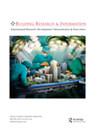多因素耦合下装配式施工技术的扩散预测
IF 3.7
3区 工程技术
Q1 CONSTRUCTION & BUILDING TECHNOLOGY
引用次数: 3
摘要
装配式建筑(PC)被认为是减少建筑行业碳排放的有效途径,越来越受到学术界和工业界的关注。然而,PC技术扩散的发展趋势仍不明朗,这不利于提高PC的推广。为了解决这一问题,本研究预测了PC技术在多因素交互作用下的扩散趋势,并揭示了其潜在机制。通过基于偏最小二乘-结构方程模型的实证研究方法,探讨PC技术扩散影响因素的意义。考虑这些关键因素的相互作用,利用系统动力学预测了PC技术的扩散趋势。结果表明,感知优势和知识共享对个人电脑技术扩散均有正向影响,并在组织氛围到个人电脑技术扩散的路径中起中介作用。网络嵌入性通过知识共享影响PC技术的扩散。在上述因素的相互作用下,PC技术在未来48个月内持续扩散直至稳定,扩散速度呈现先上升后下降的趋势。本研究的多因素耦合下PC技术的扩散预测,填补了现有研究的空白。研究结果对PC技术的有效推广具有一定的指导意义。本文章由计算机程序翻译,如有差异,请以英文原文为准。
Diffusion prediction of prefabricated construction technology under multi-factor coupling
ABSTRACT Prefabricated construction (PC) is regarded as an effective way to reduce carbon emissions in the construction sector and attracts increasing attention from academia and industry. However, the development trend of PC technology diffusion remains unclear, which is not conducive to improving the PC’s promotion. To address this issue, this study predicts the diffusion trend of PC technology considering multi-factor interaction and reveals its underlying mechanism. The significance of influencing factors of PC technology diffusion is explored through the empirical research method based on partial least squares-structural equation modelling. The diffusion trend of PC technology is then predicted using the system dynamics considering the interaction of those key factors. The results indicate that both perceived superiority and knowledge sharing have positive influences on PC technology diffusion, and they mediate the path from organizational climate to PC technology diffusion. Network embeddedness influences PC technology diffusion through knowledge sharing. Under the above-factors interaction, PC technology diffuses continuously until stability in the next 48 months, with a diffusion speed trend of first increasing and then decreasing. The diffusion prediction of PC technology under multi-factor coupling in this study fills up the gap in existing research. The conclusions are suggestive for promoting PC technology effectively.
求助全文
通过发布文献求助,成功后即可免费获取论文全文。
去求助
来源期刊

Building Research and Information
工程技术-结构与建筑技术
CiteScore
8.60
自引率
7.70%
发文量
43
审稿时长
>12 weeks
期刊介绍:
BUILDING RESEARCH & INFORMATION (BRI) is a leading international refereed journal focussed on buildings and their supporting systems. Unique to BRI is a focus on a holistic, transdisciplinary approach to buildings and the complexity of issues involving the built environment with other systems over the course of their life: planning, briefing, design, construction, occupation and use, property exchange and evaluation, maintenance, alteration and end of life. Published articles provide conceptual and evidence-based approaches which reflect the complexity and linkages between cultural, environmental, economic, social, organisational, quality of life, health, well-being, design and engineering of the built environment.
 求助内容:
求助内容: 应助结果提醒方式:
应助结果提醒方式:


